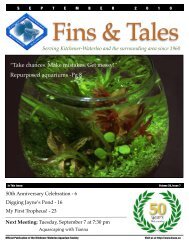June 2009 - Kitchener Waterloo Aquarium Society
June 2009 - Kitchener Waterloo Aquarium Society
June 2009 - Kitchener Waterloo Aquarium Society
Create successful ePaper yourself
Turn your PDF publications into a flip-book with our unique Google optimized e-Paper software.
J U N E 2 0 0 9<br />
are looking for and you don’t see it you can ask if it might be<br />
ordered. There may be limiting factors involved such import/<br />
export regulations or what their main suppliers themselves<br />
carry or have available. Sometimes demand can lead to stock<br />
being ordered. Communication never hurts. Look at the<br />
lighting and tank conditions that the plants are growing in. If<br />
plants are under very high light and are being fertilized or<br />
injected with CO2, don’t expect the plants to look as lush and<br />
healthy after a few weeks in your tank unless you can provide<br />
similar conditions.<br />
leaves may die off in the process. The plant may not look like<br />
the one you purchased, and I have experienced some that have<br />
a high rate of expiry while acclimating. Cryptcorynes can often<br />
be grown in an emmersed state. They are also sometimes sold<br />
as a stock with most of their leaves removed to avoid the “crypt<br />
melt” that often befalls them when acclimating.<br />
Check and compare the maximum size of the plant you are<br />
interested in. Is the plant being offered a full grown specimen?<br />
How large will it get in your tank? Will it grow out of control<br />
was acclimated? How fast will it grow? You might want a nice<br />
foreground plant and later find out that the 3 inch plant you<br />
bought is growing 12 inches or more high. Or you might put in<br />
a nice grassy plant only to find that the runners and roots have<br />
taken over half of your tank and nothing else will grow in the<br />
dense tangle of weeds.<br />
Choose good healthy specimens. Look at the roots – they<br />
should be white and strong. Blackened roots are not a good<br />
sign. Leaves should be solid and lush. Avoid plants that seem<br />
slimy or weak with stems that are soft and mushy. Check for<br />
brown dying leaves. Sometimes these occur naturally and can<br />
be simply trimmed but if the majority are looking like last<br />
week’s old salad, then you should probably pass. Look at the<br />
tank the plants are in. If there is a lot of mulm or residue it<br />
might be from leaves shedding from plants. Fine leaved stem<br />
plants will often drop their leaves like Christmas trees in<br />
January if they are unhealthy. Bunched stem plants are often<br />
bunched close together and may not be getting enough air<br />
between them. Check the bottom of the bunch for rot and decay.<br />
Often these can be simply trimmed off a bit and planted with<br />
fresh stems and they will start to root.<br />
If you are looking at plants with red colouration then consider<br />
your lighting source. Most plants with red in them require at<br />
least medium light to do well. Some may grow in low light<br />
conditions but will turn green and lose their brighter colour.<br />
Green plants should have a consistent solid colour pattern<br />
Some plants are grown on farms in an “emmersed” state. This is<br />
a means to grow plants quickly and in larger volumes partially<br />
out of water. If you see a plant labelled as something familiar to<br />
you, but the plant seems to have thicker, heavier leaves, then it<br />
may have been grown emmersed. The plant will have to<br />
acclimatize to being fully submerged again and the original<br />
Many plants are sold as bulbs. Some lotus, lilies and<br />
aponogetons are sold as leafless bulbs. Choose solid, heavy<br />
feeling bulbs. They should be somewhat hard. If they are soft or<br />
mushy or smell a bit off, they are not healthy specimens.<br />
Remember that most aponogetons go through a dormant phase<br />
in which they lose their leaves and seem dead for a few months.<br />
Many people will think they have died and throw them out but<br />
they can sprout back to life if given the chance.<br />
There is also the ever so popular snail to consider. This little<br />
creature seems harmless at first sight but from one little rascal<br />
piggybacking his way into your aquarium on a plant you can<br />
end up with hundreds of them and they may be unwanted.<br />
Some people hate them, some people work to get rid of them,<br />
going to various lengths, while some people don’t really care if<br />
they are there or not. If you do not want any snails in your tank<br />
then you should be wary on each and every plant purchase. You<br />
may wish to dip plants in a bleach bath for 15 minutes (and<br />
rinsing well) before adding them to your tank. You can inspect<br />
the plant for snails or eggs and remove them by hand, but this<br />
is tough to do with fine leaved plants.<br />
16














